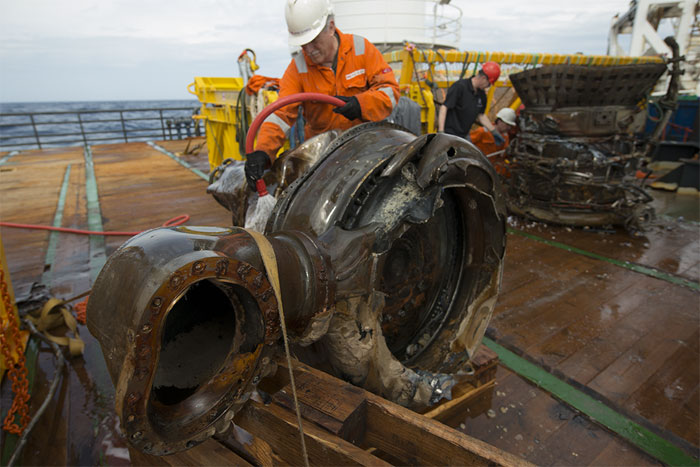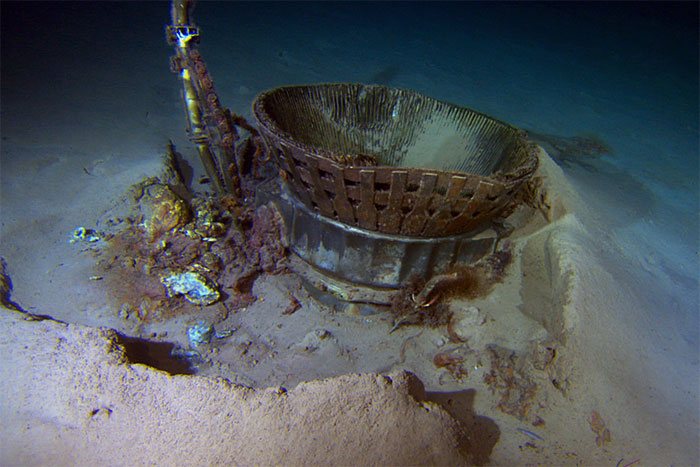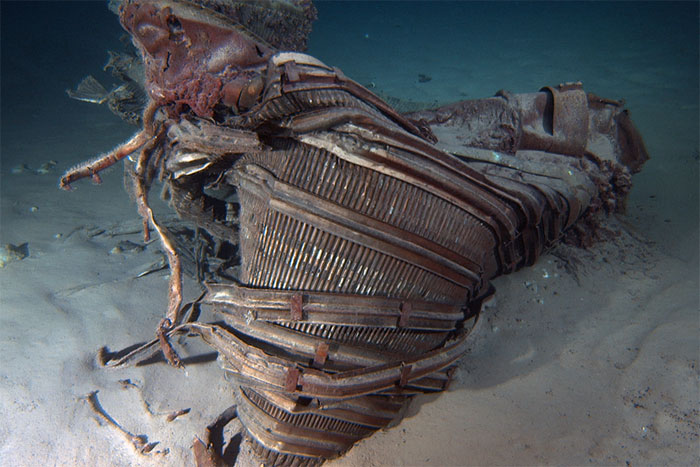.

SERIAL NUMBER 2044
When we stepped off the Seabed Worker four months ago in Port Canaveral, we had enough major components to fashion displays of two flown F-1 engines. We brought back thrust chambers, gas generators, injectors, heat exchangers, turbines, fuel manifolds and dozens of other artifacts – all simply gorgeous and a striking testament to the Apollo program. There was one secret that the ocean didn’t give up easily: mission identification. The components’ fiery end and heavy corrosion from 43 years underwater removed or covered up most of the original serial numbers. We left Florida knowing the conservation team had their work cut out for them, and we’ve kept our fingers crossed ever since.
Today, I’m thrilled to share some exciting news. One of the conservators who was scanning the objects with a black light and a special lens filter has made a breakthrough discovery – “2044” – stenciled in black paint on the side of one of the massive thrust chambers. 2044 is the Rocketdyne serial number that correlates to NASA number 6044, which is the serial number for F-1 Engine #5 from Apollo 11. The intrepid conservator kept digging for more evidence, and after removing more corrosion at the base of the same thrust chamber, he found it – "Unit No 2044" – stamped into the metal surface.
.


44 years ago tomorrow Neil Armstrong stepped onto the moon, and now we have recovered a critical technological marvel that made it all possible. Huge kudos to the conservation team at the Kansas Cosmosphere and Space Center in Hutchinson, Kansas. Conservation is painstaking work that requires remarkable levels of patience and attention to detail, and these guys have both.
This is a big milestone for the project and the whole team couldn’t be more excited to share it with you all.
Sincerely,
Jeff
March 20, 2013
What an incredible adventure. We are right now onboard the Seabed Worker headed back to Cape Canaveral after finishing three weeks at sea, working almost 3 miles below the surface. We found so much. We’ve seen an underwater wonderland – an incredible sculpture garden of twisted F-1 engines that tells the story of a fiery and violent end, one that serves testament to the Apollo program. We photographed many beautiful objects in situ and have now recovered many prime pieces. Each piece we bring on deck conjures for me the thousands of engineers who worked together back then to do what for all time had been thought surely impossible.
.
Die F-1-Bergung aus den Tiefen des Atlantik

.

.

.

.

.

.

.

Many of the original serial numbers are missing or partially missing, which is going to make mission identification difficult. We might see more during restoration. The objects themselves are gorgeous.
The technology used for the recovery is in its own way as otherworldly as the Apollo technology itself. The Remotely Operated Vehicles worked at a depth of more than 14,000 feet, tethered to our ship with fiber optics for data and electric cables transmitting power at more than 4,000 volts. We on the team were often struck by poetic echoes of the lunar missions. The buoyancy of the ROVs looks every bit like microgravity. The blackness of the horizon. The gray and colorless ocean floor. Only the occasional deep sea fish broke the illusion.
We’re bringing home enough major components to fashion displays of two flown F-1 engines. The upcoming restoration will stabilize the hardware and prevent further corrosion. We want the hardware to tell its true story, including its 5,000 mile per hour re-entry and subsequent impact with the ocean surface. We’re excited to get this hardware on display where just maybe it will inspire something amazing.
While I spent a reasonable chunk of time in my cabin emailing and working, it didn't keep me from getting to know the team. I'd like to call out a bunch of thank you’s. First of all to David Concannon who pulled together this team. The whole thing would simply have been impossible without the A-team, and I'm not sure anyone other than Dave could have brought them together.
To Rory Golden for his incredible Irish wisdom which put us on the right track multiple times. Rory also wins the best eye award - nobody could spot faint markings and mentally map twisted, corroded, 90% concealed parts like Rory. Incidentally, he's the same guy who found the main ship's wheel of Titanic, which many before had tried and failed.
To Vince Capone, who kept us organized and on track. His deep domain knowledge of recovery and his methodical, controlled approach made this mission work.
To Dr. John Broadwater for his passionate and conscientious care for the archeological mapping and conservation of our raised artifacts. He claims to have found time to sleep, but I didn't see it. He also gave us an incredible presentation of his work on raising the U.S.S. Monitor.
To Mike Kelly whose sonar interpretation made finding these needles in a haystack possible. Time after time, he took us directly to the next target.
To the ROV pilots, Hans Brygfjeld, Jarle Eide, Kai Loven, Michael McLeod, Ole Iden, Ronnie Haugland, Sean Gleason, Stewart Cruickshanks, Thoralf Moen and Troy Launay. Though underwater, operating the ROVs is called flying, and it's easy to see why. Strong currents, obscuring silt, tethers to manage and keep untangled – these guys make it look easy but it isn't. Particularly impressive was watching them rig slings to these awkward objects with the manipulator arms, three miles down. Also, role models for a can-do attitude.
To Josh Bernstein and Evan Kovacs who captured all of the amazing photographs and underwater high definition footage. Both turn out to be renaissance men explorers who were ready to help at every turn.
To Dr. Ken Kamler our team physician – we’re happy we didn’t need you, but we always knew we would be in good hands if we needed it. And thank you for the riveting lecture on your experiences on Mt. Everest.
To Arild Olsen and Oddvar Takseth, our incredibly-talented crane operators who brought the artifacts on board with the precision of surgeons. Operating any crane is difficult and requires care, but doing so on a ship at sea where the load is picking up energy with every roll and pitch, requires special art.
To Augusto Paras and his team for keeping us well fed and deliciously fed. It's sailing lore that a happy crew starts and ends with the quality of the mess. We're going to have to lose a few pounds now - and nobody's complaining.
To Captain Alf Tore Kristoffersen, Operations Manager Doug Scott and the entire crew of the Seabed Worker. This truly is a first class ship in every way, and we appreciate everything you did to make this mission successful.
To my family members, Mark Bezos, Steve Poore, Mike Bezos, and Jackie Bezos. Thanks for sharing this underwater adventure with me. We have surely traveled in a land of marvels. Mark helped make key decisions with great judgment, kept us organized, and kept us laughing, hard. Steve maintained a sense of proportion and focused us on big things at the right times. Mike and Jackie both quickly became Dr. Broadwater’s archeological assistants, and worked at all times of night and day.
.

Finally, I want to thank NASA. They extended every courtesy and every helping hand – all of NASA’s interactions were characterized by plain old common sense, something which we all know is impressive and uncommon. We're excited to be bringing a couple of your F-1s home.
Sincerely,
Jeff Bezos
.
Quelle: BEZOS
5386 Views
